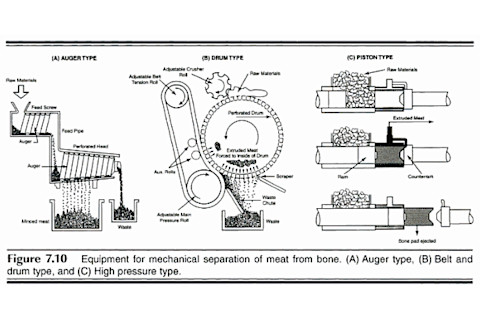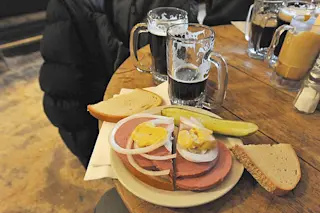Photo Credit: flickr/Jazz Guy Around autumn, students, teachers, and parents may have some big decisions to make. Private school or public? AP calculus or Art History? What to pack for lunch? Often, the answer to that last question is a bologna sandwich. Bologna is the archetypal American sandwich meat – salty, moist, and a bit mysterious. Bologna is a semisolid meat product made from one or more livestock sources, most commonly beef or pork, and may contain poultry meat. According to the Food and Drug Administration, “[Bologna] may not contain more than 30% fat or no more than 10% water, or a combination of 40% fat and added water. Up to 3.5% non-meat binders and extenders (such as nonfat dry milk, cereal, or dried whole milk) or 2% isolated soy protein may be used, but must be shown in the ingredients statement on the product's label by its common name.”^[1] In all, you can be sure that at least 45.5% of a given bologna is meat.

Photo Credit: flickr/Anne Mair Valentine In most other deli meats, the source animal is somewhat apparent through the texture and flavor of the meat (think roast turkey or ham). This is not so for bologna, because the FDA requires that all bologna ingredients be comminuted, or reduced to minute particles so that no lard, collagen, or spices are detectable on the tongue.^ [1] Essentially, the result of comminution is a “meat batter”^ [1] Most bologna producers don’t reveal the particular spice blend they use, but typical pickling spices like black pepper, coriander, and celery seed will most likely be included, as well as myrtle berries. A package labeled “Bologna with Variety Meats” can consist of no less than 15% of raw skeletal muscle meat with raw meat byproducts.^ [1] Byproducts in this case refer to non-skeletal muscle organs, like heart, kidney, or liver. Bologna of this nature must name the animal species said byproducts were sourced from, and be individually named in the ingredients list. “Mechanically Separated” means that the meat product contains more than 150 milligrams of calcium per 100 grams of product, whereas a product that falls below this threshold can list the ingredient as “pork trimmings” or “ground pork”, for example.^ [1] Some calcium inevitably joins the meat via machinery that separates meat from bone, with incredible efficiency, called Advanced Meat Recovery (AMR). Bones contain both calcium carbonate and calcium phosphate, so the 150mg calcium maximum is intended to ensure bone particulate and dust are not present in the bologna. Through AMR, the bone is to remain intact while meat is scraped, shaved, or forced off through a sieve at high pressure. Pork and poultry may be processed in this way, but regulations do not permit human food to include mechanically separated beef -- a precaution against Bovine Spongiform Encephalopathy, or Mad Cow disease.

Principles of Meat Science. 4th ed. Dubuque, IA: Kendall/Hunt The resulting pulverized/ground up, comminuted meat product is encased in a thin cellulose tube, ranging from about 0.025 mm to about 0.076 mm in thickness^[3], which is manufactured from wood pulp.^ [2] They are engineered to have elastic properties similar to natural intestinal casings used for more traditional sausages. The inner surfaces can be coated with dye and smoke flavor that diffuses into the meat product, and antibiotics may incorporated into the casing to stifle bacterial growth.^ [2] We can sing songs of our bologna’s names, we can contemplate the silliness of its pronunciation, but without some research it is difficult to discuss exactly what bologna is. Despite its enigmatic status, I hear it’s quite good when fried. Works Cited
United States. United States Department of Agriculture. Food Safety and Inspection Service. Hot Dogs and Food Safety. Web. 20 Oct. 2015.
Aberle, Elton David. "Principles of Meat Processing." Principles of Meat Science. 4th ed. Dubuque, IA: Kendall/Hunt, 2001.
Nicholson, Myron D. Method of Making a Cellulose Food Casing. Viskase Corporation, Courtaulds Fibres Limited, assignee. Patent US 5277857 A. 11 Jan. 1994. Print.
Elsbeth Sites received her B.S. in Biology at UCLA. Her addiction to the Food Network has developed into a love of learning about the science behind food. Read more by Elsbeth Sites

About the author:














